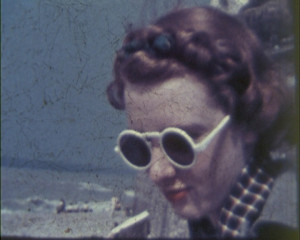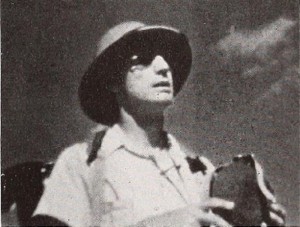A Catalonian film by Mr. John Salvans about camping in the Pyrenees.

"Amateur filmmaker, cinema historian and railway engineer H.A.V. Bulleid employs his flair for amateur production to spice up his home movies of a romantic trip to France. Acting in a moment of impulse, a man proposes to take his female friend to Paris. Leaving behind Dover's white cliffs, they arrive in Calais 'in less time than it takes to read the Bible'. Once their car - named 'Tilly' - has been unloaded, they set out to Paris via Le Tréport, Belleville, Rouen and Louviers. Arriving in the French capital they head straight to 'the film director's joy', the Avenue des Champs-Élysées and L'Arc de Triomphe, visit the Paris Bourse and tour the city's streets and boulevards. Pausing for a drink, they continue on to Place Saint-Augustin and Montmartre, dining at Moulin de la Galette - 'a tourist's paradise...pay double and eat half' - before catching a film at Studio 28. Tearing themselves away from the city of light with one last drink at Cafe George V, they drive through a gathering storm to Étaples and on to Le Touquet-Paris-Plage, 'haunt of motion picture stars', before a flurry of editing retraces their trip, marked out on a map" (EAFA Database).
Edited film "chronicling travel through Tahiti and Mo'orea including scenic landscapes, aerial views, harbor scenes, resorts, local flora, markets, underwater scenes, dance and storytelling," Human Studies Film Archives, Smithsonian Museum.
"Item is a double feature production of a trip Dr. Willinsky took to Portugal and Morocco with his wife, Sadie. In the form of a travelogue, footage of landmarks, landscapes, vegetation, historic sites and the local population is interspersed with maps and captions that were added in by Dr. Willinsky to provide context. Featured cities include Lisbon, Tangier, Casablanca and Villa Daressada. Sadie is occassionally spotted sight-seeing, interacting with locals and purchasing wares from street vendors." Ontario Jewish Archives.

"Rainbow Fantasy, in the words of Charles C. Hammack, is "an attempt to produce — not a conventional travelog — but more a story of adventure, a hiking adventure to what is probably one of the least visited of our national monuments, Rainbow Bridge, in southeastern Utah." In achieving this goal, Mr. Hammack has been largely and creditably successful. For him and his young wife, Rainbow Bridge takes on the aura of a lost horizon, a Shangri La protected from the outside world by the blistering desert heat and the brutal desert rocks. He brings this overtone of feeling to his film, both through his imaginative camera treatment of the subject and the intentionally dramatic acting of the two travelers. Mr. Hammack's is a new name in Ten Best competition, but it is one which we believe will be heard again."Movie Makers, Dec. 1943, 478.
"Ramblings Around Sydney, by James A. Sherlock, ACL, is a carefully planned and photographed motion picture study of a city, a happy example of what care and cinematic sensitivity can do for this type of subject. Although Mr. Sherlock did not commit himself to any strong continuity theme, the picture yet has a delicate cohesiveness that defied the best efforts of the earlier amateur movie makers. Outstanding are the filter shots, the shots made of city streets in the rain and the night scenes. Throughout there is a careful choice of camera viewpoint which succeeds in revealing many aspects of the city in relatively short footage. The whole is welded into an enjoyable subject that would entertain any audience." Movie Makers, Dec. 1934, 547.
"Oscar Horovitz has come through with another of his fine travelogs, this time from Burma. In Rangoon is the Shwe Dagon Pagoda, sometimes called The Golden Pagoda. It is one of the largest and most magnificent pagodas on earth and has a special sanctity to one-fifth of mankind. Another exquisite golden structure is the Sule Pagoda, the world peace pagoda. Rangoon displays the influence of the west, having fought three wars with Britain, and became a colony in 1885. Its independence was regained following World War II. Rangoon also enjoys its periods of play and the Water Festival is one of those occasions when everyone accepts a wetting in the spirit and fun of the occasion" PSA Journal, Nov. 1958, 48.
"A new illustrated lecture filmed on an amusing trip by bicycle through the isolated, unspoiled southwestern corner of Colorado." Pacific Union Recorder, Dec. 12, 1949, 4.
"A travelogue depicting the characteristics and life of this South American city. From the star, upon landing at the airfield in Rio, good photography is noted throughout the film." PSA Journal, Dec. 1955, 37.
Total Pages: 44